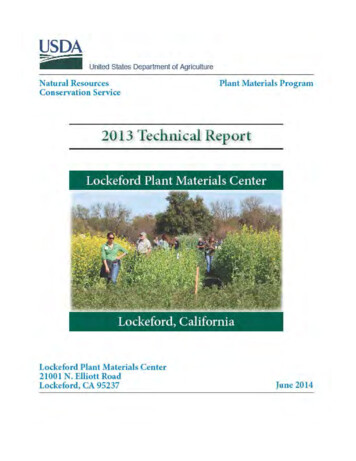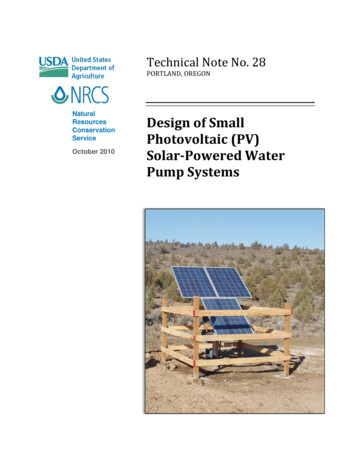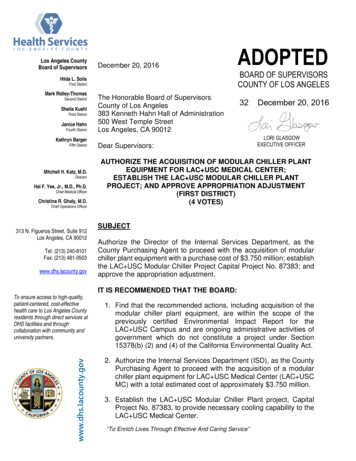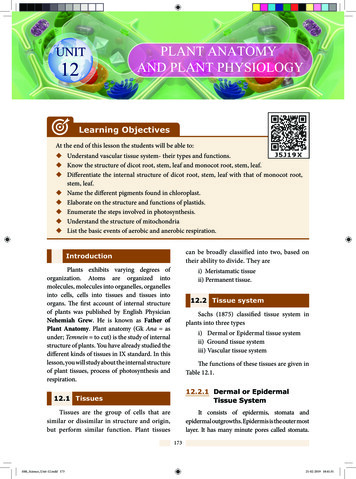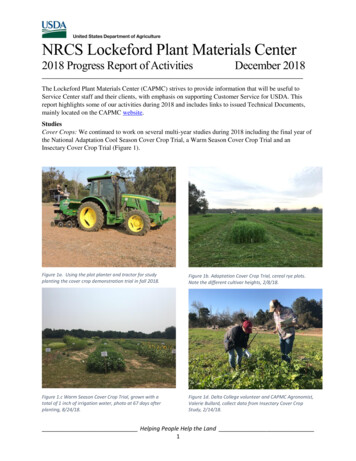
Transcription
NRCS Lockeford Plant Materials Center2018 Progress Report of ActivitiesDecember 2018The Lockeford Plant Materials Center (CAPMC) strives to provide information that will be useful toService Center staff and their clients, with emphasis on supporting Customer Service for USDA. Thisreport highlights some of our activities during 2018 and includes links to issued Technical Documents,mainly located on the CAPMC website.StudiesCover Crops: We continued to work on several multi-year studies during 2018 including the final year ofthe National Adaptation Cool Season Cover Crop Trial, a Warm Season Cover Crop Trial and anInsectary Cover Crop Trial (Figure 1).Figure 1a. Using the plot planter and tractor for studyplanting the cover crop demonstration trial in fall 2018.Figure 1b. Adaptation Cover Crop Trial, cereal rye plots.Note the different cultivar heights, 2/8/18.Figure 1.c Warm Season Cover Crop Trial, grown with atotal of 1 inch of irrigation water, photo at 67 days afterplanting, 8/24/18.Figure 1d. Delta College volunteer and CAPMC Agronomist,Valerie Bullard, collect data from Insectary Cover CropStudy, 2/14/18.Helping People Help the Land1
The National Adaptation Trial was an unirrigated, replicated trial conducted for two years to comparecultivars of cereal rye, black oat and black seeded oat, winter pea, hairy vetch, daikon radish, and red,crimson, and balansa clovers (Figure 1b). Data collection included germination, maturity dates (50%bloom or 50% anthesis), height, disease and insect resistance, biomass and nitrogen accumulation. Theseresults will provide information on the best cover crops cultivars to select for different regions in the US.Warm Season Cover Crops (WSCC) require warm temperatures for germination and growth but cannotsurvive freezing temperatures. After winterkill, the residue provides erosion control as the biomass breaksdown over the winter. The rate of decomposition, nitrogen accumulation and weed control provideddepends on the species of WSCC selected and may allow for earlier field prep and cash crop planting inthe spring, compared to cool season cover crops. This trial investigated 11 different species and 4 cowpeacultivars, all planted on June 22. A total of 1 inch of irrigation water was applied through a linearsprinkler system in ¼ inch amounts from June through August (Figure 1c, and 6c).An Insectary Cover Crop Study, in collaboration with the Xerces Society, included four mixturesspecifically designed for use in perennial systems combining native and cover crop seed (Figure 1d).Two almond mixes (an experimental almond mix and the standard Xerces almond pollinator mix), awalnut mix and a vineyard mix were planted in fall of 2017. These plots will be monitored for three yearsfor plant establishment, bloom duration, and soil health under management regimes of mowing, diskingand herbicide use.Two new trials planted in 2018 in collaboration with USDA-ARS will assess cover crop breeding lines ofcrimson clover, hairy vetch, winter pea, and fava bean.Asclepias eriocarpa, woollypodmilkweed.A. fascicularis, narrow-leavedmilkweed.A. speciosa, showy milkweedFigure 2. Milkweed plots established from seed in fall of 2017, growth by July 2018.Monarch Butterfly: A Milkweed Establishment Trial with woollypod milkweed, (Asclepias eriocarpa),narrow-leaf milkweed, (A. fascicularis), and showy milkweed (A. speciosa) evaluated establishment fromseed, plugs and rhizomes. The study was conducted in collaboration with the Xerces Society andHedgerow Farms. Replicated seed plots and rhizomes were planted in fall 2017, while plugs were plantedin early fall, early spring, and late spring. Irrigation water was applied through a drip line until the plantswere well established. Although the plots had been solarized, there was still significant weed pressure,requiring hand weeding. All three-species established from seed and plugs, although growth was betterHelping People Help the Land2
with fall and early spring plantings. Showy milkweed grew from rhizomes, while the narrowleafmilkweed did not (no woollypod rhizomes were planted in this trial).Field PlantingsField Plantings offer an opportunity for the CAPMC to collaborate with NRCS field offices (FO) andNRCS partners on a study or demonstration with the aim of providing information that is directlyapplicable to their situation. In 2018, several field plantings were either initiated or continued across thestate to evaluate cover crop, or range mixes in real world settings (Figure 3). NRCS field plantingsincluded: increasing infiltration in a walnut orchard and improving forage production in rangeland in SanJoaquin County with the Stockton FO; monitoring drought resilience in a walnut orchard in TulareCounty with the Visalia FO; monitoring soil health properties in a prune orchard in Sutter County withthe Yuba City FO; soil health improvement in an organic citrus orchard in Ventura County with theOxnard FO. Soil health assessments and plant species evaluations will be collected yearly, prior totermination. After three years, a technote or case study will be written, summarizing the results.Other field plantings in collaboration with East Stanislaus RCD included cover crop demonstrations inorchards and row crops in Tulelake, Salinas, Fowler, and Victorville. For more information on these fieldplanting projects please contact Valerie Bullard, PMC Agronomist.Kate Howard and Kyle Venell fromYuba City FO take soil samples froma cover crop planting in a pruneorchard in Sutter Co., April 2018.Cover crop field plantingevaluations with Rob Roy and BrookGale in a young walnut orchard inTulare County, April 2018Sonya Miller, Stockton FO, takingcover crop evaluations for a fieldplanting in a walnut orchard in SanJoaquin County, April 2018.Figure 3. Field Plantings in 2018 with thanks to the Stockton, Yuba City and Visalia Field Offices.Trainings at the PMCThe CAPMC held several trainings both at the PMC and at Field Days around the state to speak onfindings from the cover crop studies (Figure 4). Trainings at the PMC included: Sacramento Valley Range and Pasture Seeding Workshops for Area 1 employees at the PMC on2/28/2018 and 3/13/2018.Cover Crop Selection and Adaptation Training. A full day event held at the PMC as part of aWestern SARE grant from the East Stanislaus RCD for Conservation Planners on 3/14/2018.Helping People Help the Land3
Figure 4a. Participants at the Western SARE cover croptraining in March 2018.Figure 4b. Participants in the Range Seeding trainingcounting seeds as part of a seeder calibration activity.Figure 4. Training Events held at the PMC during 2018.The CAPMC is grateful for assistance from 3 students from Delta College in Stockton and 2 studentsfrom American River College in Sacramento. They were signed up as Earth Team volunteers andassisted us during the year (Figure 5).American River College volunteerand Farm Foreman, MatthewBronson, erected an owl boxAmerican River College volunteer,sampling radish from AdaptationCover Crop StudyDelta College volunteers holdingtillage radish samples from thecover crop plantings.Figure 5. Activities carried out by student Earth Team volunteers.Outreach to NRCS Customers, Partners and the PublicIt was a busy year at the PMC and we are grateful for the support of many individuals and groups.Partners included the East Stanislaus and San Joaquin Resource Conservation Districts, and non-profitorganizations including the Xerces Society, the Intertribal Agriculture Council, the Lockeford ProtectionHelping People Help the Land4
District and UC Extension, particularly San Joaquin County. Use of the PMC as an outreach sitecontinued with the following events held at the PMC (Figure 6):Figure 6a. PMC Agronomist, Valerie Bullard explainingfindings from the Adaptation Cover Crop Study at the OpenHouse, 4/4/18.Figure6c. Wendy Rash, District Conservationist, Vacaville,speaks on NRCS Conservation Programs at the WSCC FieldDay, 8/22/2018.Figure 6b.Hudson Minshew, State Agronomist,speaking to CA Secretary of Agriculture Karen Ross at CDFASoil Health Field Tour for Agriculture Council, 6/22/18.Figure 6d Students from 3 local High Schools participate ina FARMS leadership event working to make cuttings ofnative plants, 11/29/18.Figure 6. Outreach events held at the PMC during 2018. Annual CAPMC Open House focusing on Cover Crops and Riparian Restoration, 4/4/2018Figure 6a). Attended by 66 people including NRCS, RCD, producers and the public. Our lunchsponsor was the San Joaquin RCD.Warm Season Cover Crop Field Day with 50 attendees, including NRCS Service Center staff andproducers, 8/22/2018 (Figure 6c).Area 3 DC Meetings, 4/11/2018 and 9/11/2018; Area 3 All Employee Meeting, 9/12/2018.California Agriculture Council for a Soil Health and Cover Crops Tour. Organized by CDFA, CASecretary of Agriculture attended with representatives from the Farm Bureau, Almond Allianceand Strawberry Commission, 6/22/2018 (Figure 6b).The Center for Land Based Learning, held a FARMS (Farming, Agriculture and ResourceManagement for Sustainability) training day at the PMC on 11/29/2018, with teachers andHelping People Help the Land5
students from local high schools learning about agriculture careers and plant propagation (Figure6d).Native plants including elderberry and yarrow were grown at the CAPMC in a Partnership withinterns from the Intertribal Agriculture Council, UC Arboretum and provided to the MaiduSummit Consortium for planting into the Humbug Valley.An Agreement with the BLM provided plant materials for restoration activities to the MotherLode Field Office with plant materials grown for the Pine Hill and Cosumnes Preserves.Technical DocumentsThese publications were produced during 2018 and intended to provide technical information and supportto our Area, Field Office and Service Center staff. These publications (apart from the Case Studies thatcan be found in the eFOTG) are posted on the CAPMC website and can be accessed from the links n/plantmaterials/pmc/west/capmc/:Case Studies: Brief location-based information.Analysis of Soil Health Properties in a California Prune Orchard.Commercial Pollinator MixesMaturation Dates of Warm Season Cover Crops.Winterkill Cover Crop DemonstrationPlant Guides:Great Valley Phacelia, Phacelia ciliataLacy Phacelia, Phacelia tanacetifoliaWhiteleaf Manzanita, Arctostaphylos manzanitaTechnical Notes:Revised Cover Crop Chart for CaliforniaCover Crop Seed Vendors for Western StatesVideo: “Maximizing cover crop benefits for growers” produced by op-benefits-growers/A revised version of the eVeg Guide (Version 4) http://www.calflora.org/nrcs/index.html was released onNovember 15, 2017 for initial testing for improvement. This is the result of extensive work by Dr. KenLair, with input from Area Offices, State Office Leads and CAPMC staff over the past year.The Lockeford Plant Materials CenterThe Lockeford Plant Materials Center is a 106- acre facility located in the Central Valley of Californiaand is the only PMC within the state. There are 27 PMCs around the country, with each one serving aspecific ecological and geographic area. The CAPMC addresses the resource concerns within theMediterranean climate areas of California. We work with NRCS field offices, public agencies,universities, conservation organizations, tribes, commercial seed producers and nurseries.Lockeford PMC StaffManager: Margaret Smither-KopperlAgronomist: Valerie BullardFarm Foreman: Matthew BronsonTechnical and Admin. Assistant: Shawn VueAddressLockeford Plant Materials Center21001 N. Elliott Road, (P.O. Box 68)Lockeford, CA 95237Tel: 209 727 5319Contact InformationFor more detailed information contact the CAPMC or email: Margaret.Smither-Kopperl@ca.usda.govHelping People Help the Land6
Figure 1a. Using the plot planter and tractor for study planting the cover crop demonstration trial in fall 2018. Figure 1.c Warm Season Cover Crop Trial, grown with a total of 1 inch of irrigation water, photo at 67 days after planting, 8/24/18. Figure 1b. Adaptation Cover Crop Trial, cereal rye plots. Note the different cultivar heights, 2/8/18.
